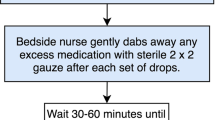Abstract
Objective
To investigate the efficacy of paracetamol in reducing pain during examination for retinopathy of prematurity (ROP) in preterm infants.
Methods
A total of 114 infants undergoing eye examination for retinopathy of prematurity screening were prospectively randomized. Topical anesthetic (Proparacaine; Alcaine® drop 0.5 %) was applied 30 s before the eye examination in all the infants. The infants in the intervention group (Group 1, n = 58) received 15 mg/kg of oral paracetamol, 60 min before the examination. The control group (Group 2, n = 56) received the same volume of sterile water per oral with an opaque syringe. Primary outcome measurement was pain assessed by Premature Infant Pain Profile (PIPP) score. Secondary outcome measurements were tachycardia (>180 bpm)/bradycardia (<100 bpm), desaturations (<85 % for >10 s), and crying time.
Results
The groups were similar for gestational age, birthweight or postnatal age at examination. The intervention group had a significantly lower mean PIPP score during eye examination, following insertion of the speculum [Group 1:12 (9–13) vs. Group 2:14 (13–15), p 0.001]. There were no significant differences between the groups with regard to crying time and the number of the patients with tachycardia/bradycardia and desaturation.
Conclusions
Oral paracetamol modestly reduces pain scores during eye examinations. Further cross-over trials on dose and frequency of paracetamol and combination of pharmacological with non-pharmacological approaches and paracetamol alone as a single agent in significant pain reduction are needed.


Similar content being viewed by others
References
Early Treatment for Retinopathy of Prematurity Cooperative Group. Revised indications for the treatment of retinopathy of prematurity: results of the early treatment for retinopathy of prematurity randomized trial. Arch Ophthalmol. 2003;121:1684–94.
Belda S, Pallas CR, De la Cruz J, Tejada P. Screening for retinopathy of prematurity: is it painful? Biol Neonate. 2004;86:195–200.
Grunau R. Early pain in preterm infants. A model of long-term effects. Clin Perinatol. 2002;29:373–94.
Bhutta AT, Anand KJS. Vulnerability of the developing brain: neuronal mechanisms. Clin Perinatol. 2002;29:357–72.
van Sleuwen BE, Engelberts AC, Boere-Boonekamp MM, Kuis W, Schulpen TW, L’Hoir MP. Swaddling: a systematic review. Pediatrics. 2007;120:e1097–106.
Golianu B, Krane E, Seybold J, Almgren C, Anand KJS. Non-pharmacological techniques for pain management in neonates. Semin Perinatol. 2007;31:318–22.
Stevens B, Yamada J, Ohlsson A. Sucrose for analgesia in newborn infants undergoing painful procedures. Cochrane Database Syst Rev. 2010;1:CD001069.
Taddio A, Ohlsson A, Einarson TR, Stevens B, Koren G. A systematic review of lidocaine-prilocaine cream (EMLA) in the treatment of acute pain in neonates. Pediatrics. 1998;101:E1.
Anand KJS, Hall RW, Desai N, et al; NEOPAIN Trial Investigators Group. Effects of morphine analgesia in ventilated preterm neonates: primary outcomes from the NEOPAIN randomised trial. Lancet. 2004;363:1673–82.
Green SM, Denmark TK, Cline J, Roghair C, Abd Allah S, Rothrock SG. Ketamine sedation for pediatric critical care procedures. Pediatr Emerg Care. 2001;17:244–8.
Ribeiro LM, Castral TC, Montanholi LL, et al. Human milk for neonatal pain relief during ophthalmoscopy. Rev Esc Enferm USP. 2013;47:1039–45.
Costa MC, Eckert GU, Fortes BG, Fortes Filho JB, Silveira RC, Procianoy RS. Oral glucose for pain relief during examination for retinopathy of prematurity: a masked randomized clinical trial. Clinics (Sao Paulo). 2013;68:199–204.
Dilli D, İlarslan NE, Kabataş EU, Zenciroğlu A, Şimşek Y, Okumuş N. Oral sucrose and nonnutritive sucking goes some way to reducing pain during retinopathy of prematurity eye examinations. Acta Paediatr. 2014;103:e76–9.
Stevens B, Johnston C, Petryshen P, Taddio A. Premature infant pain profile: development and initial validation. Clin J Pain. 1996;12:13–22.
Anderson BJ, Pons G, Autret-Leca E, Allegaert K, Boccard E. Pediatric intravenous paracetamol (propacetamol) pharmacokinetics: a population analysis. Paediatr Anaesth. 2005;15:282–92.
Alegaert K, Van der Marel CD, Debeer A, et al. Pharmacokinetics of single dose intravenous propacetamol in neonates: effect of gestational age. Arch Dis Child Fetal Neonatal Ed. 2004;89:F25–8.
Seifi F, Peirovifar A, Gharehbaghi M. Comparing the efficacy of oral sucrose and acetaminophen in pain relief for ophthalmologic screening of retinopathy of prematurity. Am J Med Sci Med. 2013;1:24–7.
Fierson WM; American Academy of Pediatrics Section on Ophthalmology; American Academy of Ophthalmology; American Association for Pediatric Ophthalmology and Strabismus; American Association of Certified Orthoptists. Screening examination of premature infants for retinopathy of prematurity. Pediatrics. 2013;131:189–95.
Malnory M, Johnson TS, Kirby RS. Newborn behavioral and physiological responses to circumcision. MCN Am J Maternal Child Nurs. 2003;28:313–7.
Macke JK. Analgesia for circumcision: effects on newborn behavior and mother/infant interaction. J Obstet Gynecol Neonatal Nurs. 2001;30:507–14.
Badiee Z, Torcan N. Effects of high dose orally administered paracetamol for heel prick pain in premature infants. Saudi Med J. 2009;30:1450–3.
Contributions
EUK: Drafting the paper, eye examination of the patients and case collection; AD, SB, DD and AZ: Drafting the paper, case collection and final review; NO: Drafting the paper and final review. DD will act as guarantor for this paper.
Conflict of Interest
None.
Source of Funding
None.
Author information
Authors and Affiliations
Corresponding author
Rights and permissions
About this article
Cite this article
Kabataş, E.U., Dursun, A., Beken, S. et al. Efficacy of Single Dose Oral Paracetamol in Reducing Pain During Examination for Retinopathy of Prematurity: A Blinded Randomized Controlled Trial. Indian J Pediatr 83, 22–26 (2016). https://doi.org/10.1007/s12098-015-1765-8
Received:
Accepted:
Published:
Issue Date:
DOI: https://doi.org/10.1007/s12098-015-1765-8




